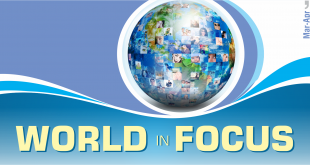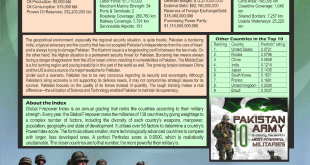The Hawks again Stalk the Doves
While making his New Year’s resolution for 2018, the Secretary-General of the United Nations, António Guterres, came up with a message to the world: “When I took office one year ago, I appealed for 2017 to be a year for peace. Unfortunately – in fundamental ways, the world has gone in reverse. On New Year’s Day 2018, I am not issuing an appeal. I am issuing an alert — a red alert for our world. Conflicts have deepened and new dangers have emerged. Global anxieties about nuclear weapons are the highest since the Cold War….” Though the world has not felt the heat radiated by various boiling cauldrons around the world, the recent developments bear out the fact that the heightened tensions are unprecedented and may burn the world peace to ashes any time.
The conflicts in the entrails of the world are consuming it from within. They include the issues in the Middle East, Afghanistan, Congo, Somalia, South Sudan, Nigeria and North Korea, plus the growing populism. Their culmination into an absolute chaos cannot be ruled out.
Is the threat of Third World War looming large? The answer, in my opinion, is a ‘yes’. The world learnt the lesson of peace after the two deadly World Wars – by the time the damage was done — and it finally resorted to peaceful coexistence, forming the United Nations Organization (UNO). Now after more than a half century has elapsed, many rue that the world on the whole has turned a blind eye to the Charter of the United Nations – the document that seeks to promote the agenda of peace across the globe – for many countries are making a mockery of it.
The topsy-turvy situation of the world order does not augur well. The simmering cauldrons of the world might explode any time. In a speech delivered on November 02, 2017, in Italy, Pope Francis warned that “the world once more is at war and is preparing to go even more forcefully into war”. Pope’s concerns do not end here. His recurring caveats indicate inadequacies in the maintenance of peace. On January 15, 2018, he cautioned the world yet another time about the looming World War and the devastation it would carry. His concern is glimpsed in his words: “I think we are at the very limit. I am really afraid of this. One accident is enough to precipitate things.”
What if Secretary General of the UN has warned the world about the fragile world peace? For, he is certainly supposed to do so. What if Pope Francis has spoken on the deteriorating situation of peace? For, he is rightly expected to promote peace around the world.
No! There is more to the story. The Chinese President Xi Jinping, speaking at the ninth BRICS summit in September 2017, was quoted as saying: “[I]ncessant conflicts in some parts of the world and hotspot issues are posing challenges to world peace.” Hence, such an evaluation by China – a strong candidate of becoming a world power – speaks volumes about the gravity of the situation.
As the upcoming events start casting their shadows earlier, there are many issues that paint a ghastly picture of chaos in the foreseeable future. The Middle East theatre of war warrants a special mention in this regard. The war-ravaged region is mired in conflicts and it has now become a boiling cauldron. Wars in Syria, Yemen and Iraq have cost millions of lives, besides rendering numerous people homeless. On the one hand, the people in these countries are at the mercy of the ISIS while the region has become a battleground of proxy wars, on the other. The United States and its allies vis-à-vis the Russian camp fight for getting the hold of the region, multiplying the plights and miseries of the populace; meaning thereby that the region may face an intense, bloody war.
Then, there is the war of Afghanistan to win which the world’s sole superpower has left no stone unturned but the victory is still elusive. The war-torn country has now become a base for ISIS, and hence, a threat to regional as well as global peace. It is apt to mention here that Afghanistan shares borders also with some Middle Eastern countries – the states that have already become boiling cauldrons.
Added to these are the impoverished states on the African continent; Somalia, South Sudan, Nigeria and Congo are grappling with wars and unending crises. Ravaged by civil war, Somalia has now become a haven for ISIS warriors. South Sudan, too, is mired in a prolonged civil war and millions of its citizens are now leading a life of misery, to say it mildly.
Additionally, Boko Haram is to Nigeria what ISIS is to the Middle East. Though the Nigerian government has claimed to curtail the influence of the very terror group, the release of a threatening video in the start of February 2018 by Abubakar Shekau, the leader of the group, is a spine-chilling development that indicates the otherwise ground realities of the country. In addition, the Democratic Republic of Congo has also been suffering from internal unrest amidst a political turmoil that has permeated the country during the past one year, with the surge in ethnic violence in the start of February 2018. Hence, the volcanoes of the African continent may also erupt anytime in the near future.
Moreover, the rise of populism around the world has also aggravated the situation. The chronically fragile world peace suffered a serious blow when Donald J. Trump rose to the US presidency. Furthermore, the Britain’s exit from the European Union, that is Brexit, and the sweeping wave of populism across Europe – exemplified by the rise of Nazi-like Alternative for Deutschland (AfD) party in Germany and the formation of Austrian government by the far-right Freedom Party (FPO) – are shocking developments that portray the flashpoints in the West.
The story will remain incomplete without the mention of the standoff between North Korea and the United States. The two are at loggerheads over the issue of possession of nuclear weapons. The latter wants to denuclearize the former but that is a hard pill to swallow for the DPRK. The United States has long been at variance with the communist regime but the new cast of characters under Trump has adopted a more tough rhetoric, bringing about new levels of hostilities. The two states have picked up pace in threatening one another with nuclear weapons. Any military provocation between the two could turn out to be a total catastrophe of the world.
Above all, the chronic issues like Kashmir and Palestine are also turning into powder keg. For, the peace in the Middle East as well as South Asia is hinged on the resolution of these issues. If left unsolved, the regions might reach the boiling point and the heat would be felt across the globe.
The formation of alliances is also on the horizon, which is a bad omen for world peace. The unipolarity of the US is breathing its last and the waxing of multi-polarity is visible, with the resurgence of Russia and China as the prospective superpowers. The former is trying its best to defend its position while the latter are trying to wield their clout.
True, the world is more peaceful after two World Wars; common man is freer than ever before; he is more prosperous; states are more independent; imperial conspiracies are farther from common man, but this is an undeniable world phenomenon that the periods of peace and disquiet alternate. After the period of peace for over half a century, the current circumstances suggest the turn of turmoil now. The world is going tri-polar – an unprecedented phenomenon. Cyberwar among world powers is an added yet never-seen-before danger. Perhaps, the world powers want to create issue after issue just for the sake of maintaining their hegemony over the world with an utter disregard to the humanitarian crises it may ensure.
 Jahangir's World Times First Comprehensive Magazine for students/teachers of competitive exams and general readers as well.
Jahangir's World Times First Comprehensive Magazine for students/teachers of competitive exams and general readers as well.



